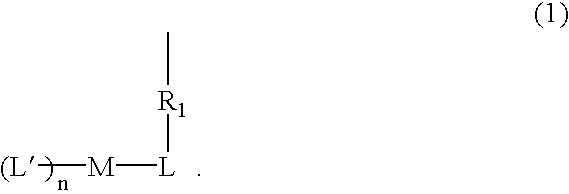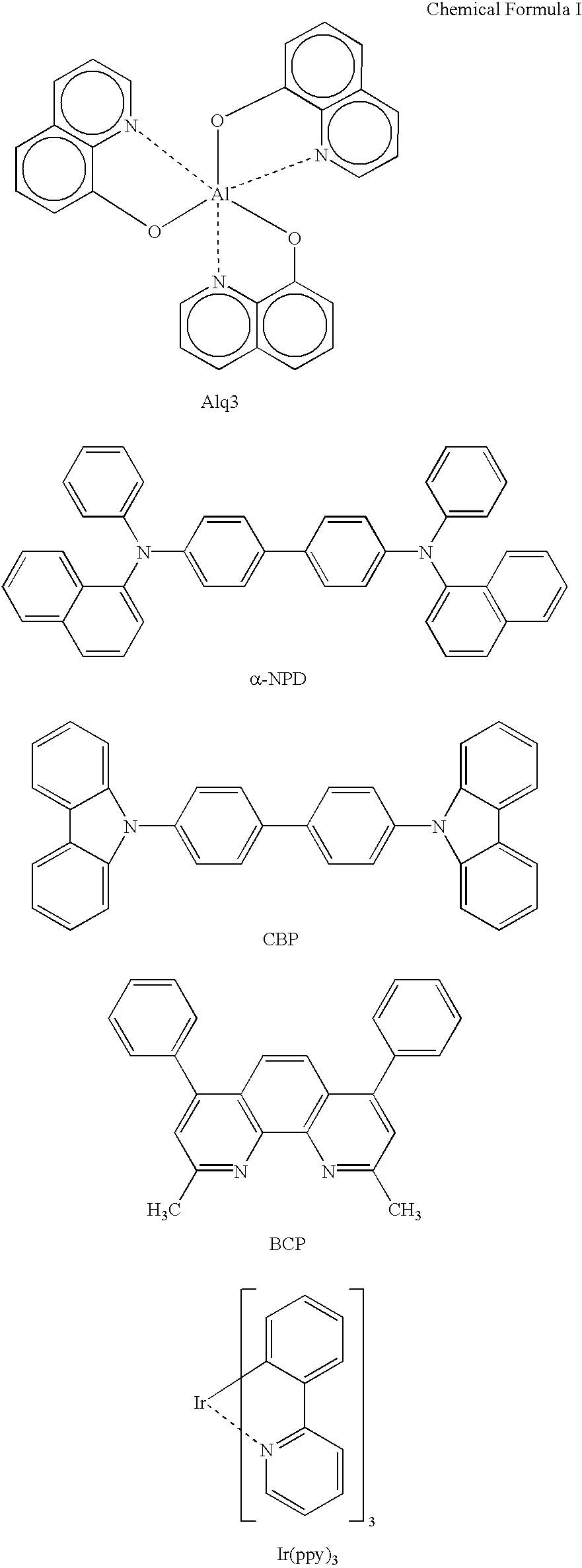Polymer compound and electroluminescent element
a technology of polymer compound and electroluminescent element, which is applied in the direction of discharge tube/lamp details, natural mineral layered products, synthetic resin layered products, etc., can solve the problems of affecting the synthesis yield of a single compound, and a single compound is described. achieve the effect of improving the yield of synthesis and facilitating the formation of a polymer
- Summary
- Abstract
- Description
- Claims
- Application Information
AI Technical Summary
Benefits of technology
Problems solved by technology
Method used
Image
Examples
example 1
[0098]An Ir monomer metal complex compound of the present invention can be obtained through a synthesis flow chart shown below.
[0099]
[0100]Specifically, in a 200 ml 3-necked flask, 60 ml of ethoxyethanol, 0.76 g (0.6 mole) of tetrakis[1-phenylisoquinoline-C2, N](μ-dichloro)diiridium(III), 0.38 g (1.8 mmol) of acetoacetoxyethyl methacrylate (manufactured by Tokyo Kasei Co.), 0.84 of sodium carbonate, and 0.0005 g of benzene-1,4-diol (hydroquinone) were charged, agitated for 1 hour in a nitrogen flow at room temperature, and then heated under agitation for 4 hours at 100° C. The reaction product was cooled with ice, then 50 ml of water were added, and a precipitate was separated by filtration and washed with water. The precipitate was washed with 30 ml of ethanol, then dissolved in chloroform, and, after removal of insoluble matters, purified by recrystallization with chloroform / methanol to obtain 0.55 g (yield 54%) of the compound 1a in red powder.
[0101]The M+ of 813 of this compound...
example 2
[0105]A monomer was synthesized following the same procedure as Example 1 with the exception that 1-(4-octylphenyl)isoquinoline was employed instead of 1-phenylisoquinoline employed in Example 1. The yield was 50%, and an M+ value 1038 of this compound was confirmed by means of MALDI-TOF MS. A toluene solution of this compound showed an emission spectrum with λmax at 624 nm.
[0106]This compound was subjected to polymerization at the same molar ratio as in Example 1, to obtain a polymer compound (Mn=52,000; Mw / Mn=1.4 (in THF, converted in terms of polystyrene standard)).
example 3
[0107]A monomer was synthesized following the same procedure as Example 1 with the exception that 2-phenylpyridine was employed instead of 1-phenylisoquinoline employed in Example 1. The yield was 60%, and an M+ value 714 of this compound was confirmed by means of MALDI-TOF MS. A toluene solution of this compound showed an emission spectrum with λmax at 520 nm.
[0108]This compound was subjected to polymerization at the same molar ratio as in Example 1, to obtain a polymer compound (Mn=39,000; Mw / Mn=1.3 (in THF, converted in terms of polystyrene standard)).
PUM
| Property | Measurement | Unit |
|---|---|---|
| thickness | aaaaa | aaaaa |
| excitation wavelength | aaaaa | aaaaa |
| temperature | aaaaa | aaaaa |
Abstract
Description
Claims
Application Information
 Login to View More
Login to View More - R&D
- Intellectual Property
- Life Sciences
- Materials
- Tech Scout
- Unparalleled Data Quality
- Higher Quality Content
- 60% Fewer Hallucinations
Browse by: Latest US Patents, China's latest patents, Technical Efficacy Thesaurus, Application Domain, Technology Topic, Popular Technical Reports.
© 2025 PatSnap. All rights reserved.Legal|Privacy policy|Modern Slavery Act Transparency Statement|Sitemap|About US| Contact US: help@patsnap.com



